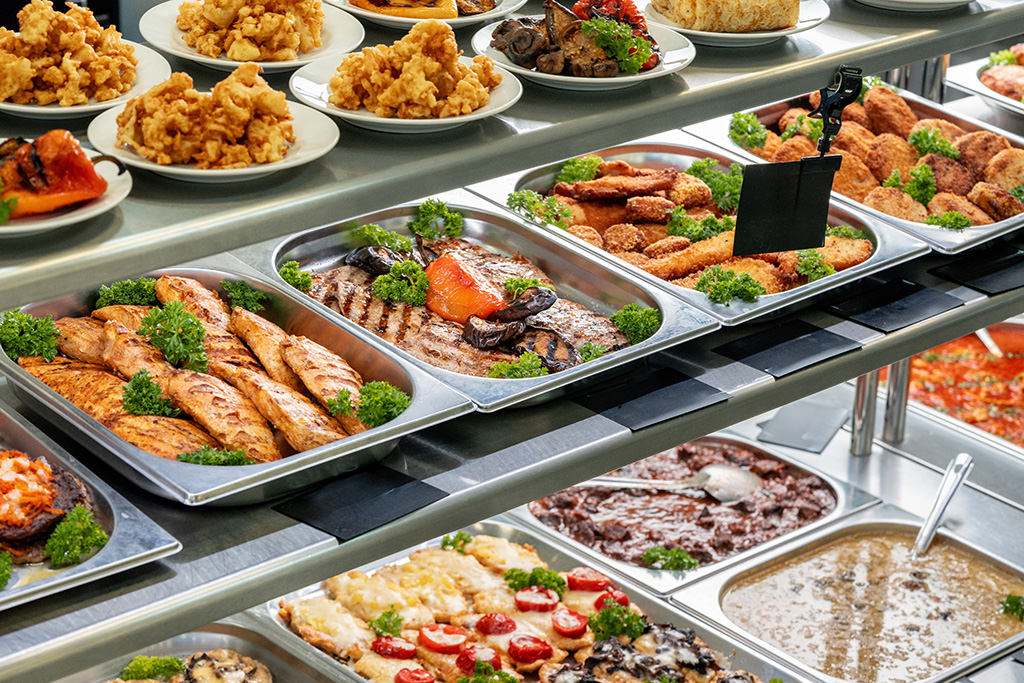
Feeding the Future: Institutional Food Supply Trends in 2025 – Part 4
10/23/2025
Part 4: Emergency Preparedness & Food Security in Institutional Settings
Why Long-Term Storage Foods and Disaster Readiness Are Back in Focus
For institutions tasked with feeding thousands of people daily—whether schools, hospitals, or correctional facilities—food security isn’t just about today’s menu, it’s about tomorrow’s crisis. From climate-driven disasters and cyberattacks to global supply chain instability, institutional kitchens are once again prioritizing preparedness. The disruptions of COVID-19 and the severe weather events of recent years made it clear: having reliable, long-term food reserves is essential for operational continuity.
In fact, FEMA recommends that organizations responsible for vulnerable populations maintain at least 72 hours of emergency food supplies, while many institutions are now planning beyond that, investing in weeks’ worth of shelf-stable reserves. GoodSource Solutions plays a critical role in this trend, helping schools, healthcare facilities, and corrections systems prepare with long-life food products, storage strategies, and distribution continuity planning.
Long Shelf-Life Food Options: The Foundation of Readiness
When emergencies strike, shelf-stable and frozen foods become lifelines. Items such as canned proteins, powdered dairy, dehydrated fruits and vegetables, and fortified meal replacements ensure that institutions can continue providing safe, compliant meals even if fresh supply lines are disrupted.
Hospitals, for instance, are increasingly stockpiling medically tailored shelf-stable foods for patients with chronic conditions, recognizing that nutrition continuity is a matter of health outcomes. Schools are purchasing larger reserves of non-perishable snacks and meal kits to prepare for natural disasters or transportation strikes. Correctional facilities, often located in remote areas, are prioritizing long-life staples to safeguard against weather-driven delivery failures.
GoodSource supports these efforts with an extensive portfolio of emergency-ready food products designed for extended storage without compromising on nutritional standards.
Continuity Planning for Institutional Kitchens
Preparedness goes beyond storing food—it requires a continuity plan that addresses procurement, storage, and logistics. A continuity plan ensures that foodservice operations can adapt quickly when disruptions occur, protecting both populations served and institutional reputations.
Key elements of continuity planning include:
- Diversified sourcing: Multiple suppliers for critical items prevent single-point failure.
- Redundant logistics: Backup delivery routes and carriers minimize downtime.
- Inventory rotation: Ensuring stockpiled goods are cycled into daily menus before expiration.
- Menu flexibility: Having pre-approved “emergency menus” using shelf-stable and frozen products.
According to the National Association of State Procurement Officials, institutions that integrate continuity planning into procurement reduce operational risk and improve resilience during crises.
GoodSource helps clients implement these frameworks by offering strategic menu planning, data-driven ordering cycles, and multi-region distribution redundancy—all essential components of reliable continuity.
Responding to Modern Threats: More Than Weather
While hurricanes, wildfires, and winter storms remain major drivers of food preparedness, today’s institutions must also plan for non-traditional threats. Cyberattacks on transportation systems, geopolitical conflicts disrupting global trade, and even labor strikes in trucking or rail industries can cause just as much disruption as a natural disaster.
For hospitals, where uninterrupted nutrition is tied directly to patient care, downtime is not an option. For corrections, disruptions can pose security and safety risks. And for schools, meal program interruptions impact not just nutrition but also equity, since many children rely on school meals as their primary food source.
The Department of Homeland Security has repeatedly emphasized the importance of resilient supply chains as a national security priority (DHS Supply Chain Resilience Guide). GoodSource aligns with this perspective, ensuring that institutional clients aren’t caught unprepared when modern threats emerge.
Examples of Emergency Readiness in Action
- Healthcare Systems: During the Texas winter storms of 2021, hospitals that had invested in shelf-stable reserves were able to continue operations even as supply trucks were delayed for days. Since then, many have expanded their emergency nutrition programs to cover at least one week of self-sufficiency.
- Schools: Districts in hurricane-prone regions are adopting prepackaged shelf-stable meal kits that can be distributed to students during closures, ensuring continuity of federally funded lunch programs.
- Corrections: Facilities in wildfire-prone states are working with distributors like GoodSource to create emergency menus that can be prepared with minimal staffing or power outages, reducing risk during operational strain.
These examples highlight how proactive planning saves costs, reduces risk, and ensures safety for populations who cannot go without reliable food access.
GoodSource as a Partner in Preparedness
Institutions don’t need to tackle emergency preparedness alone. GoodSource has decades of experience helping critical sectors design and execute readiness plans that balance cost, compliance, and operational practicality.
We provide:
- Shelf-stable & long-life product portfolios tailored for schools, healthcare, and corrections.
- Menu planning support for emergency scenarios.
- Multi-region logistics to ensure distribution redundancy.
- Data reporting to track inventory rotation and optimize stockpiles.
By partnering with GoodSource, institutions gain peace of mind knowing they are not just reacting to crises, but proactively prepared for them.
Looking Ahead
Emergency preparedness in institutional foodservice is no longer optional—it’s a baseline requirement for responsible operations. With climate change increasing the frequency of extreme weather, cyber and infrastructure risks on the rise, and global supply chains under constant pressure, institutions must think strategically about resilience.
By investing in long shelf-life food options, continuity planning, and resilient supply partnerships, schools, hospitals, and corrections facilities can ensure that meal service remains uninterrupted no matter the challenge.
And with GoodSource as a trusted partner, these institutions aren’t just stockpiling food—they’re building comprehensive food security strategies that protect the health, safety, and trust of the populations they serve.
